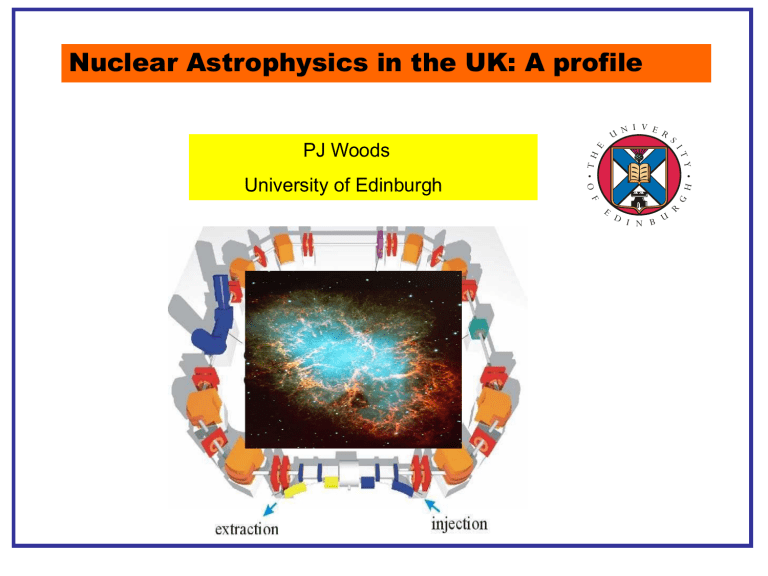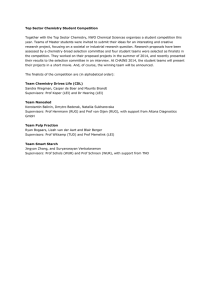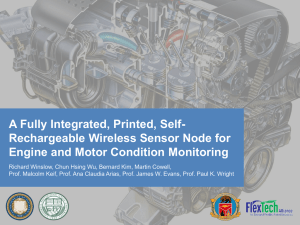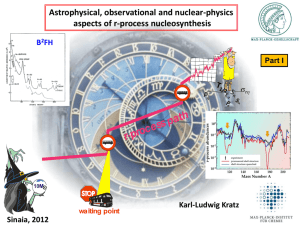Phil Woods

Nuclear Astrophysics in the UK: A profile
PJ Woods
University of Edinburgh O
F
T
H
E
E
U N
I V E R
S
I T
Y
D I N B U
R
G
H
Academics and Research Fellows
Edinburgh University
M. Aliotta, A. Kankainen (Finnish Senior Fellowship), C. Lederer,
(Schroedinger Fellow, Austria), A. Murphy, A Shotter (Emeritus Prof.),
P.J. Woods and L. Zhang (Chinese Scholarship Council Fellow)
York University
C Diaget, B Fulton, A Laird
Surrey University
G. Lotay (Ernest Rutherford Fellow)
This underestimates the actual effort as there is often strong overlap with nuclear structure eg M Freer (Birmingham), Z Podolyak (Surrey),
A Bruce (Brighton), D Jenkins (York) and nuclear matter, D Watts
(Edinburgh), and astrophysical modelling, R Hirschi (Keele), T
Rauscher (Hertfordshire)
Advanced Implantation Detector Array (AIDA) will be used for decay studies of r-process nuclei at RIKEN and FAIR compact high density ASIC electronics instrumentation for multi-channel
Double-sided Silicon Strip Detectors (DSSD)
238
U fission fragments from Super FRS
O
F
T
H
E
E
U N
I V E R
S
I T
Y
D I N B U
R
G
H
Observations of Elemental Abundances in old metal poor stars:
Evidence for robust r-process mechanisms
However, for elements below Z ~50 eg Yttrium evidence of need for a second astrophysical mechanism/site
Sites of the r-process
R-process related to environments with high-neutron density and high temperature.
Type II supernovae prime suspects …
N eutron star mergers and accretion disks in g
ray bursts promising alternatives.
Not enough is known at present about the physics to create realistic models
First direct evidence for neutron star merger - kilonova
Hubble space telescope images of afterglow of a gamma-ray burst, Berger et al. arXiv:1306
Accessing the r-process path at RIKEN and FAIR b
-delayed n-emission branchings
(final abundances ) b
-decay half-lives
(progenitor abundances, process speed)
Masses (Sn)
(location of the path)
BRIKEN collaboration formed for proposed campaign of
β-n measurements on Big RIPS separator@RIKEN
Also plans to couple to Total Absorption Spectroscopy system
GT
– strength function measurements
Puzzle of the origin of heavy ‘p-nuclei’ – abundant proton-rich isotopes eg 92 Mo and 96 Ru
Supernova shock passing through
O-Ne layers of progenitor star
Study of 96 Ru(p,
γ) 97 Rh reaction with decelerated beams using the ESR storage ring at GSI
Fully stripped
96 Ru 44+ ions
Gas Stripper
Carbon Foil
Stripper ions injected
@ 100 MeV/u
Reduced to
~10MeV/u
Pioneering new technique on ESR (Heil, Reifarth) – heavy recoils detected with double-sided silicon strip detector (Edinburgh)
Particle detectors
Position distribution of recoiling ions measured by DSSD
Gas jet
σ(p,γ)= 3.6(5) mb ~10 in UHV on ESR to measure p-process capture reactions in
Gamow burning energy region – test run 2 weeks ago
Faster cooling and deceleration for RIB with CRYRING
The
15 O(
, g
) 19 Ne
reaction: the nuclear trigger of X-ray bursts
Reaction regulates flow between the hot CNO cycles and rp process
critical for explanation of amplitude and periodicity of bursts
15 O( α,γ) 19 Ne reaction rate predicted to be dominated by a single resonance at a CoM energy of 504 keV
Key unknown α-decay probability from excited state at
4.03 MeV in 19 Ne compared to
γ-decay, predicted to be ~ 10 -4
Study of the p( 20 Ne, 2 H) 19 Ne transfer reaction on the ESR heavy ion storage ring @GSI, PJW, Y Litvinov et al.
10 8 20 Ne ions
@ 50 MeV/u
ESR
Electron cooler
10 13 H
2
/cm 2 gas target
A few hours of data from test run on ESR
DT Doherty, PhD Thesis (2014)
TSR@ISOLDE project – Injection of Radioactive Ion Beams into ring at MeV/u energies
Spokesperson K Blaum (MPIK,Heidelberg)
Deputies R Raabe (Leuven) PJW (Edinburgh) entire issue of EPJ 207 1-117 (2012)
ISOLDE site (west) side
23.3m
24.6m
3m
Proposed layout to fit the TSR at the west side:
- Installation above the CERN infrastructure-tunnel
18
ISOL-SRS Project
31 proposers:
• Prof. Andrei Andreyev
•
Dr. Marialuisa Aliotta
• Prof. Jon Billowes
• Dr. Andrew Boston
•
Prof. Peter Butler (deputy)
• Prof. Wilton Catford
University of York
University of Edinburgh
University of Manchester
University of Liverpool
University of Liverpool
University of Surrey
• Prof. Bob Chapman University of the West of Scotland
• Prof. Swapan Chattopadhyay
•
*Dr. Bradley Cheal
• *Dr. Thomas Cocolios
•
Dr. Dave Cullen
• Dr. Thomas Davinson
• *Dr. Kieran Flanagan
•
Prof. Sean Freeman (deputy)
• Dr. David Jenkins
•
Dr. David Joss
• Dr. Marc Labiche
Cockcroft Institute and Universities of Liverpool, Manchester and Lancaster
University of Liverpool
University of Manchester
University of Manchester
University of Edinburgh
University of Manchester
University of Manchester
University of York
University of Liverpool
STFC Daresbury Laboratory
• Dr Alison Laird University of York
•
Mr. Ian Lazarus STFC Daresbury Laboratory
• Dr. Annika Lohstroh
•
*Dr. Gavin Lotay
• Dr. Alex Murphy
University of Surrey
University of Surrey
University of Edinburgh
• Prof. Robert Page
•
Dr. Shrikant Pattalwar
• Prof. Paddy Regan
University of Liverpool
STFC Daresbury Laboratory
University of Surrey/National Physical Laboratory
• Dr Marcus Scheck University of the West of Scotland
• Prof. John Simpson STFC Daresbury Laboratory
•
• Dr. John Smith
Prof. Phil Walker
University of the West of Scotland
University of Surrey
• Prof Carsten Welch University of Liverpool and Cockcroft Institute
• Prof. Phil Woods (Spokesperson) University of Edinburgh
* 4 STFC Advanced/Rutherford Fellows
In-ring DSSD System for ultra-high resolution (d,p), (p,d) and ( 3 He,d) transfer studies of astrophysical resonances
UK ISOL-SRS project
For ultra high resolution mode resolution should be entirely limited by transverse beam emittance
resolutions approaching 10 keV FWHM attainable
External solenoid spectrometer (Helios-type system) for (d,p) transfer reaction studies on heavy nuclei outside the ring eg for studies of shell evolution in near r-process nuclei detector
1m uniform field
Double-sided silicon strip detector + read-out
1 m uniform field
Final state resolution approaching 20 keV
High resolution d( 26g Al,p) 27 Al study of analog states of 27 Si resonances using TUDA Si array @ ISAC II Triumf proton
150 MeV 26g Al (CD
2
) n target
I beam
~ 5*10 8 pps
G. Lotay, PJW et al.
0 increasing excitation energy
Astrophysically
Important
Region
Key analog states
Exotic reaction since J
π
= 5 + for 26g Al!
Galactic abundance distribution of the cosmic
γ-ray emitter 26 Al
INTEGRAL satellite telescope - 2.8(8) M sun
[R. Diehl , Nature 439 45(2006) ] of 26 Al in our galaxy
Supernova Cycle
n_TOF facility (CERN) new EAR_2 beam line
measurement of key 26 Al(n,p) destruction reaction
C Lederer et al.
EAR-2
Neutron beam
Test Setup at GELINA Belgium (IRMM)
E-detector
10
B
Worlds most enriched
26
Al target owned by IRMM
26
Al dE-E-detectors
THE LUNA EXPERIMENT
GAMMA background
Gamow peak energies
Other nuclear astrophysics activities at the following facilities where, unless stated, role is mainly as users:
In Europe:
France (GANIL - ad hoc silicon reaction chamber set-ups for individual experiments, Orsay)
Finland (Jyvaskyla)
Germany (Munich, FRANZ in the near future)
Rest of the World:
US (Argonne – FMA Focal plane DSSD system, MSU, Texas A+M –
Tiara development, Notre Dame)
China (Lanzhou)
Nuclear Physics in Astrophysics VII will be jointly hosted by York and
Edinburgh (A Laird, M Aliotta Conf co-Chairs) in York 2015






